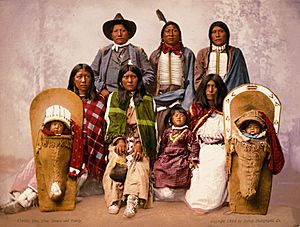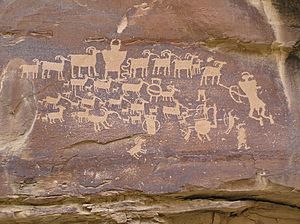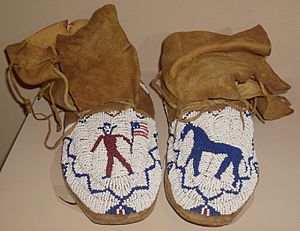Indigenous peoples of the Great Basin facts for kids

The Indigenous Peoples of the Great Basin are Native American groups. They live in the northern Great Basin, the Snake River Plain, and the upper Colorado River basin. The "Great Basin" is a special cultural area. It is located between the Rocky Mountains and the Sierra Nevada mountains. This region includes parts of Nevada, Oregon, California, Idaho, Wyoming, and Utah. When Europeans first arrived, the Great Basin was about 400,000 square miles. This area gets very little rain. This lack of water greatly shaped the lives and cultures of the people living there.
Contents
Who Are the Great Basin Peoples?
Many different Native American groups have lived in the Great Basin for a very long time. They each have their own unique traditions and languages. However, they also share many things because they lived in the same dry environment.
- Fremont culture (400 CE–1300 CE), Utah
- Kawaiisu, southern inland California
- Timbisha or Panamint or Koso, southeastern California
- Washo, Nevada and California
- Pahkanapil
Northern Paiute People
The Northern Paiute lived in eastern California, Nevada, Oregon, and southwestern Idaho.
- Kucadikadi, also known as Mono Lake Paiute, from California.
- Bannock, from Idaho.
Mono People
The Mono lived in southeastern California.
- Eastern Mono, also called Owens Valley Paiute.
- Western Mono.
Southern Paiute People
The Southern Paiute lived in Arizona, Nevada, and Utah.
- Chemehuevi, from southeastern California.
- Kaibab, from northwestern Arizona.
- Moapa, from southern Nevada.
- Panguitch, from Utah.
- Shivwits, from southwestern Utah.
Shoshone People
The Shoshone people are divided into three main groups: Eastern, Northern, and Western.
Eastern Shoshone
The Eastern Shoshone lived in areas like Wyoming. Some of their groups were:
- Guchundeka' or Kuccuntikka, also known as Buffalo Eaters.
- Tukkutikka or Tukudeka, also known as Mountain Sheep Eaters.
- Boho'inee' or Pohoini, also known as Sage Grass people.
Northern Shoshone
The Northern Shoshone lived in Idaho and parts of Utah. Some of their groups were:
- Agaideka or Salmon Eaters, also known as Lemhi. They lived near the Snake River.
- Kammedeka or Jack Rabbit Eaters, who lived near the Snake River and Great Salt Lake.
- Tukudeka or Sheep Eaters, who lived in the Sawtooth Range, Idaho.
Western Shoshone
The Western Shoshone lived mostly in Nevada and Utah. Some of their groups were:
- Goshute or Kusiutta, who lived in the Great Salt Desert and Great Salt Lake, Utah.
- Cedar Valley Goshute
- Deep Creek Goshute
- Skull Valley Goshute
- Kuyatikka or Bitterroot Eaters, from Nevada.
- Tipatikka or Pinenut Eaters, a northern group.
- Tsaiduka or Tule Eaters, from Railroad Valley, Nevada.
Ute People
The Ute lived in Colorado, Utah, and New Mexico. They are also divided into groups.
Northern Ute
The Northern Ute lived in central and northern Utah and Colorado.
- San Pitch, from central Utah.
- Timpanogos, from north central Utah.
- Uncompahgre (Tabeguache), from central and northern Colorado.
- Uintah.
- White River Utes, from Colorado and eastern Utah.
- Parianuche, along the Colorado River valley.
- Yampa.
Southern Ute
The Southern Ute lived in southeastern Colorado and New Mexico.
Ute Mountain Ute
The Ute Mountain Ute lived in western Colorado, eastern Utah, and northwestern New Mexico.
Other Ute Groups
Some Ute groups were later absorbed by the Paiute Indian Tribe of Utah.
- Moanunts, from Salina, Utah.
- Pahvant, from western Utah.
History of the Great Basin Peoples
The history of the Great Basin peoples goes back thousands of years. From about 9,000 BCE to 400 CE was the Great Basin Desert Archaic Period. After that came the Fremont culture. These people were both hunter-gatherers and farmers. Around the 14th century CE, people who spoke Numic languages arrived. These were the ancestors of today's Western Shoshone, Northern Paiute people, and Southern Paiute people.
The first Europeans to visit the area were the Spanish in 1776. However, not many non-Native settlers came until 1847. That's when the first Mormon settlers arrived. Within ten years, the first Indian reservation was created. This was done to try and make Native people live like the settlers. For example, Native children were sent to Indian schools. The land and resources of the reservations were also limited.
Because they met Europeans later than some other tribes, Great Basin tribes kept their religions and cultures strong. They were leaders in new cultural and religious movements in the 1800s. Two Paiute prophets, Wodziwob and Wovoka, started the Ghost Dance. This ceremony helped people connect with loved ones who had passed away. It also aimed to bring back buffalo herds and old ways of life. The Ute Bear Dance also began in the Great Basin. The Sun Dance and the Peyote religion also became important in this region.
In the 1900s, conditions for Native Americans in the Great Basin changed. In the 1930s, President Franklin Roosevelt's Indian New Deal helped improve their economic situation. Later, in the 1970s, activism and legal victories led to more improvements. Today, Native American self-determination allows Great Basin tribes to create their own economic opportunities. This began with the Indian Self-determination and Education Assistance Act in 1975.
Great Basin Cultures
The different Native American groups in the Great Basin share many cultural traits. Most of them traditionally speak Numic languages. Historically, these groups lived peacefully and often shared land. Before the 1900s, Great Basin peoples were mainly hunters and gatherers.
Their culture is sometimes called "Desert Archaic" or "The Desert Culture." This name comes from their need to move around. They followed the seasons to find food. They rarely used pottery because it was heavy. Instead, they made amazing baskets. These baskets were used for carrying water, cooking, and storing food like pine nuts. Heavy tools were often hidden and left behind instead of being carried everywhere.
People in the Great Basin did not practice agriculture in the main basin area. Farming there today needs large water systems. They also did not have permanent towns. Instead, families would return to the same winter villages year after year. In the summer, families often traveled in small groups. This was because food sources were spread out.
In later history, some Great Basin tribes moved north and east. There, they learned to ride horses and hunt bison. These groups, like the Bannock and Eastern Shoshone, became more like the Plains Indians.





